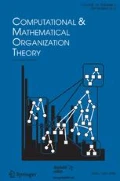Abstract
This paper rigorously shows in the framework of poly-agent systems theory that it is very natural for an innovative society to emerge stratification of networks to cope with complexity intelligent decision makers of it have to deal with. Before introducing poly-agent systems theory, I will first refer to empirical observations of emergence of stratification of networks in innovative societies, which motivate this research. I, then, theoretically show that coexistence of both networks and hierarchies is reasonable and inevitable for a tightly interrelated society because it can provide the decision makers with mediation, which is beneficial for the decision makers as well as the society as a whole. Finally, I will go back again to implications from our theoretical study.
Similar content being viewed by others
References
Auger, P. (1989), Dynamics amd Thermodynamics in Hierarchically Organized Systems: Applications in Physics, Biology and Economics. Pergamon Press, Oxford.
Bennett, P.G. (1980), “Hypergames: Developing a Model of Conflict, ” Futures, 12(6), 489–507.
Bennett, P.G. and M.R. Dando (1979), “Complex Strategic Analysis: A Hypergame Study of the Fall of France, ” J. Opl. Res. Soc., 30(1), 23–32.
Bennett, P.G., M.R. Dando and R.G. Sharp (1980), “Using Hypergames to Model Difficult Social Issues: An Approach to the Case of Soccer Hooliganism, ” J. Opl. Res. Soc., 31(7), 621–635.
Bennett, P.G., S. Cropper and C. Huxham (1989) “Modelling Interactive Decisions: The Hypergame Focus, ” in J. Rosenhead (Ed.) Rational Analysis for a Problematic World. John Wiley and Sons, Chichester.
Carley, K.M. and D.M. Svoboda (1996), “Modeling Organizational Adaptation as a Simulated Annealing Process, ” Sociological Methods and Research, 25(1), 138–168.
Carver, N. and V. Lesser (1994), “The Evolution of Blackboard Control Architectures, ” Expert Systems and Applications, 7(1), 1–30.
Checkland, P.B. (1981), Systems Thinking, Systems Practice. John Wiley, Chichester.
Checkland, P.B. (1990), Soft Systems Methodology in Action. John Wiley, Chichester.
Fraser, N.M. and K.W. Hipel (1984), Conflict Analysis: Models and Resolutions. North-Holland, Amsterdam.
Fraser, N.M., M. Wang and K.W. Hipel (1991), “Hypergame Theory in 2-Person Conflicts, ” Information and Decision Technology, 16, 301–319.
Galbraith, J. (1977), Organization Design. Addison-Wesley, Reading, MA.
Gibbons, R. (1992), A Primer in Game Theory. Harvester Wheatsheaf, London.
Harsanyi, J. (1967), “Games with Incomplete Information played by Bayesian Players, Parts I, II and III, ” Management Science, 14, 159–182, 320–334, 486–502.
Howard, N. (1987), “The Present and Future of Metagame Analysis, ” European Journal of Operational Research, 32, 1–25.
Howard, N. (1989), “The Manager as Politician and General: The Metagame Approach to Analysing Cooperation and Conflict, ” in J. Rosenhead (Ed.) Rational Analysis for aProblematicWorld. JohnWiley and Sons, Chichester.
Howard, N. (1990), “Soft Game Theory, ” Information and Decision Technologies, 16(3), 215–227.
Howard, N. (1994), “Drama Theory and Its Relation to Game Theory: Part One, ” Group Decision and Negotiation, 3, 187–206.
Howard, N., P. Bennett, J. Bryant and M. Bradley (1993), “Manifesto for a Theory of Drama and Irrational Choice, ” Systems Practice, 6(4), 429–434.
Kijima, K. (1991), “Decision Making Based on Subjective Evaluations of Problem Situation, ” T. IEE, Japan 111-C(3), 98–106, in Japanese.
Kijima, K. (1996a), “Intelligent Poly-Agent Learning Model and its Application, ” Information and Systems Engineering, 2, 47–61.
Kijima, K. (1996b), Negotiation and Accommodation. Nikkagiren Publishing Co., Tokyo, in Japanese.
Kijima, K. (1999), “Poly-Agent Systems Theory: Evolution Model and Its Applications, ” in A.M. Castell et al. (Eds.) Synergy Matters: Working With Systems in the 21st Century, in Proceedings of UKSS99 held at Lincoln, UK, Plenum Press, 577–582.
Levitt, R.E., G.P. Cohen, J.C. Kunz, C.I. Nass, T. Christiansen and Y. Jin (1994), “A Theoretical Evaluation of Measures of Organizational Design: Interrelationship & Performance Predictability, ” in K.M. Carley and M.J. Prietula (Eds.) Computational Organization Theory, Lawrence Erlbaum Associates, Hillsdale, NJ.
Mesarovic, M.D. and Y. Takahara (1989), Abstract Systems Theory. Springer Verlag, Berlin.
Neches, R. et al. (1991), “Enabling Technology for Knowledge Sharing, ” AI Magazine, 12(3), 36–56.
Neches, R. (1993), “Knowledge Sharing Effort, ” Research Report, available at http.stanford.edu in /pub/knowledge-sharing/papers.
Nishio, K. (1999), History of Japan. Mainichi Shinnbunn, Tokyo, in Japanese.
Rosenhead, J. (Ed.) (1989), Rational Analysis for Problematic World. John Wiley, Chichester.
Saxenian, A. (1996), Regional Adventure: Culture and Competition in Silicon Valley and Route 128. Harvard University Press.
Simon, H.A. (1962), “The Architecture of Complexity, ” Proceedings of the American Philosophical Society, 106, 467–482.
Suematsu, T. (1997), “Cultural Comparison Between Organizations in Silicon Valley and Japan: An Approach from IT Utilization, ” Journal of Association for Management Informatics, 16(3), 23–40, in Japanese.
Takagi, H. et al. (1995), Societies in Malti-media Age. Nikkagiren Publishing Co., Tokyo, in Japanese.
Van Gigch, J.P. (1991), System Design Modeling and Metamodeling, Plenum Press, New York.
Wang, M., K.W. Hipe and N.M. Frase (1988), “Modeling Misperceptions in Games, ” Journal of Behavior Science, 33, 207–223.
Wang, M. and K.W. Hipe (1992), “Misperception and Bargaining in the Persian GulfWar, ” Control and Cybernetics, 10(2), 1–26.
Wonham, W.N. (1976), “Towards an Abstract Internal Model Principle, ” IEEE Trans. Systems, Man and Cybernetics, IEEE-SMC, 6(11), 735–740.
Author information
Authors and Affiliations
Rights and permissions
About this article
Cite this article
Kijima, K. Why Stratification of Networks Emerges in Innovative Society: Intelligent Poly-Agent Systems Approach. Computational & Mathematical Organization Theory 7, 45–62 (2001). https://doi.org/10.1023/A:1011377532016
Issue Date:
DOI: https://doi.org/10.1023/A:1011377532016




